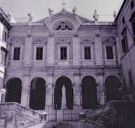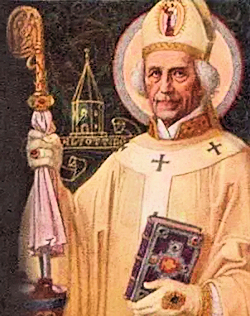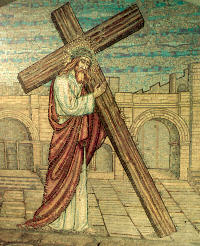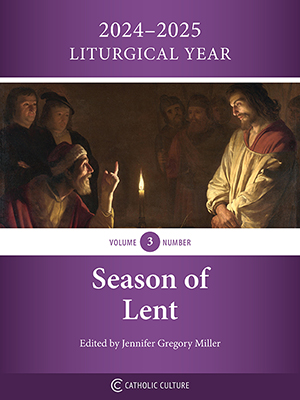Lent: March 27th
Friday of the Fourth Week of Lent
Other Commemorations: St. Rupert, Bishop (RM)
» Enjoy our Liturgical Seasons series of e-books!
"We have been ransomed with the precious blood of Christ, as with the blood of a lamb without blemish of spot (1 Pt 1:19)." Mortification and self-denial are indispensable means of acquiring strength of will and virtuous habits, and of preserving the life of the soul.
According to the 1962 Missal of Bl. John XXIII the Extraordinary Form of the Roman Rite, today is the feast of St. John Damascene. His feast in the Ordinary Form of the Roman Rite is celebrated on December 4.
Meditation - The Eloquence of Jesus' Silence
How singularly majestic must have been the eloquence of Jesus, when as a boy He sat among the doctors of the law in the temple, or when He thrilled the multitudes, commanded the winds and waves, and put to flight diseases and demons and death itself! Yet, perhaps nowhere else did the majesty of His eloquence reveal itself, as it did in that heroic calm and consistent silence, which reached its climax in the three hours of His agony.
But what should strike us most forcibly, and yet most sweetly, is the interior silence of Jesus, the silence of His innermost soul and heart, of His human passions, of His feelings and thoughts and fancies. Recall the word of Jesus, that from the heart come forth evil works, bitter zeal, and false testimonies and blasphemies (Matt. 15:19); and then dwell on His own strikingly consistent example of quashing all bitterness and quenching all the fires of passion, and of refraining from impatience, anger, and retaliation, even when tongues all around were busy kindling fires of hateful calumnies against His truest self-knowledge and wounding His livest self-respect.
Hence, pray that you may see deep into the interior soul of Jesus, there to realize the true majesty and marvelous eloquence of the silence of His lips and tongue, the silence which was the fruit of His charity and of the interior peace and perfection of right order that ever reigned within the sanctuary of His heart, the silence which was the precious fruit of the obedience and humility in His absolute abandonment to the mysterious providence of His Father in heaven.
Excerpted from Our Way to the Father, Rev. Leo M. Krenz, S.J.

The Station is in the church of St. Eusebius, priest of Rome, who suffered for the faith in the Arian persecution under the emperor Constantius.
St. Rupert of Salzburg
 St. Rupert was the first bishop of Salzburg, who, in some legends, is credited with giving the city its name.
St. Rupert was the first bishop of Salzburg, who, in some legends, is credited with giving the city its name.
Rupert was born in the late seventh century, to a part of the French imperial family. Little is known about his early life, but, like many sons of noblemen, entered the clergy. Rupert was elected bishop of Worms, a German city that was an important seat of power in the Carolingian dynasty.
At first, Rupert's flock welcomed his presence as a caring and faithful bishop. All too soon, however, the relationship between Rupert and the people of Worms soured. Conveniently, a Bavarian Duke, Theodo, asked for Rupert to come south to his palace at Regensburg to come spread Christianity to the diverse tribes he ruled over in Bavaria.
Rupert is often credited with baptizing Theodo, and officially welcoming him into the Church, as the seventeenth-century painting to the left depicts. And with Theodo's blessing, he began his missionary work among the Bavarian tribes.
Rupert found that Bavaria was still, in many ways, truly a wilderness with lots of outbreaks of violence. Thus, Rupert traveled to an old ruined Roman city and renamed it "Salzburg." Rupert founded and rebuilt several different monasteries in the area and lay the foundations of the Salzburg Cathedral. Where, a little over a thousand years later, Wolfgang Amadeus Mozart was baptized.
Rupert died in 710, and there's some dispute whether he had returned back to Worms at the time of his death or whether he died in Salzburg. His successor, Bishop Vergilius of Salzburg, interred his remains in the newly-finished Salzburg Cathedral in 774.
Rupert is known as the "Apostle to the Bavarians" and is a patron saint of Salzburg, Austria, and salt miners.
—Excerpted from Faith ND
Patronage: city of Salzburg, Austria; province of Salzburg, Austria; archdiocese of Salzburg; salt miners
Symbols and Representation: man holding a container of salt (refers to Salzburg and the salt mining there); wearing clerical clothes including mitre; holding a crosier
Highlights and Things to Do:
- Read more about St. Rupert:
- Read about St. Rupert's Fair, the biggest traditional fair in Europe.
- See the Stift St. Peter -- St. Peter's Abby that St. Rupert restored and lived.
- St. Rupert's remains are located at the Salzburg Cathedral at the Volksaltar.






